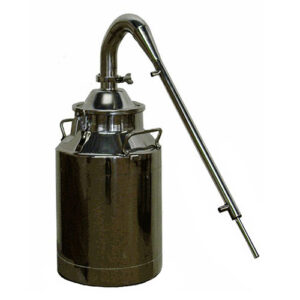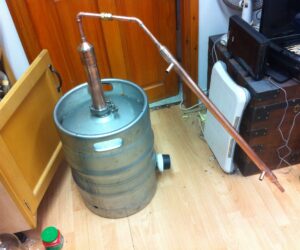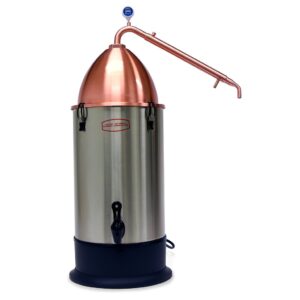Definition:
One batch at a time. The Pot in the name refers to where the mash is heated.
How it works
At standard atmospheric pressure, alcohol boils at 78 °C (172 °F), while water boils at 100 °C (212 °F). By boiling an alcohol mash slightly above 172 deg the alcohol will evaporate along with some water
When the alcohol is evaporated other material from the mash also is carried in the steam. This gives the flavored taste when the liquid is later condensed.
Parts of Pot Still
Pot
The large metal boiling chamber where the fermented liquid from a strained mash is heated to steam evaporation levels.
Cap
There is a space above the boiling mash liquid that is called the cap. This is a small area or short column where vapors rise. This is called the swan neck. The heavier particles from the mash can only float so high and then fall back to the mash in the pot. This falling back down is called reflux.
Lynne Arm
The alcohol and small mash particles of the heated vapor transfers in the Lynne arm to the condenser. This arm is horizontal or even slightly pointing down to connect to the condenser.
Condenser
– cools the vapor to yield distillate
and then the steam can then be cooled and condensed into a liquid containing mostly approximately 70% alcohol. The percent of alcohol depends on the alcohol strength contained in the prepared mash being distilled.

Largest
80,000 liter behemoths at the Middleton Distillery, Ireland, is the largest in the world that is in current operation. The largest ever, not currently in use, was also made at Midelton Distillery with a capacity of 140,000 liters.
Traditionally constructed from copper because
By law, cognac, Irish and Scotch malt whiskies, and single pot still whiskey must be distilled using a pot still
Commercial vodka: methanol 0.013%, fusils 0.48% ethanol 99.507%,
Home distilled spirit (untreated): = methanol 0.0067%, fusils 0.361%, ethanol 99.632%,
Poor quality home distilled spirit : methanol 0.0186%, fusils 1.528% ethanol 98.453%,


Procedure——————————–
1 Must be carefully siphoned off its yeast sediment before being transferred to the distilling pot.
2 heat pot to evaporation point of methanol
3 slowly increase 5 deg
4 remove Foreshots [meaning before shots] a shot glass is filled with the methanol …
5 With the pressure cooker top lid fastened on the pressure cooker and the condenser hooked up, raise the temperature to 175 deg. At this temperature the alcohol will start evaporating.
, raise the temp slowly until there is a steady drip of one drip a second. This should be around 175 deg. Wait until the shot glass fills (50 ML), then throw out this liquid. Any remaining methanol and other undesirable liquids not previously burned off will be in this liquid. The liquid will be mostly alcohol at this point. This is enough to discard to make sure you have no methanol or other undesirable liquids from this point on. If you are distilling a large 4 gallon batch then you will want to throw out twice that amount.
These discards are traditionally called foreshots, “fore” as in before, and “shots” as in shot glasses.
When the drips from the condenser slows, raise the temperature slowly by five degrees. Continue this procedure until the temperature get to 185 deg. Do not raise the temperature over 190 deg. Water boils at 212 deg. The temperature cannot be precisely determined or controlled. So after 190 deg. the alcohol will be evaporating with water and you will get watered down alcohol. When the drips stop at 190 deg., you are finished distilling.
The first 75% of the amount you collected from distilling is called the hearts. This is the premium alcohol.
The last 25% of the amount you collected from distilling is called the tails. So-so quality but still drinkable.
The pot stills of 80,000 liter behemoths at the Middleton Distillery, Ireland, is the largest in the world that is in current operation. The largest ever, not currently in use, was also made at Midelton Distillery with a capacity of 140,000 liters.

More Flavors come through when distilling with a pot still.
This shows the tradition of pot stills being constructed from copper



